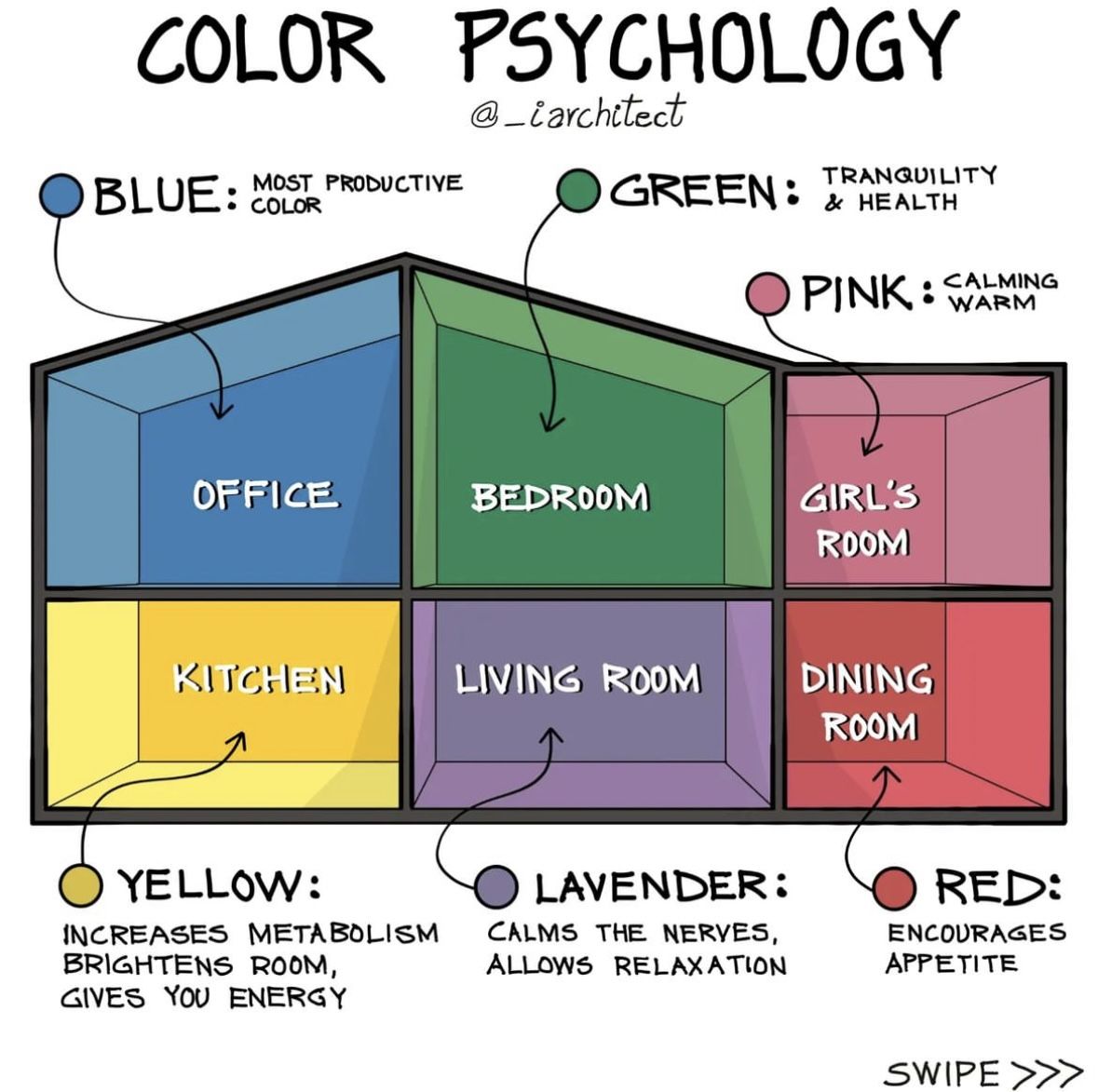From calming greens in the bedroom to energizing yellows in the kitchen, architects reveal how the right colors transform spaces into powerful tools for wellbeing.

When you step into a room, you don’t just see the walls—you feel them. The colors that surround us influence mood, behavior, and even physical health. The infographic on color psychology in home design makes one thing clear: picking paint isn’t just about style, it’s about shaping how you live.
🎨 Why Color Psychology Matters in Homes
Our brains respond subconsciously to color. Warm tones can stimulate appetite or activity, while cool shades can calm nerves and sharpen focus. This is why interior designers, architects, and even psychologists emphasize intentional color use in different rooms.
The chart shows a perfect example of room-to-color matching:
- Office – Blue: Known as the most productive color, blue stimulates focus and helps maintain concentration, making it ideal for workspaces.
- Bedroom – Green: Green symbolizes tranquility and health, perfect for restful sleep and balance.
- Girl’s Room – Pink: A calming, warm shade that feels nurturing and cozy.
- Dining Room – Red: Red is appetite-enhancing, stimulating conversation and food enjoyment.
- Living Room – Lavender: Soft lavender soothes the nerves and allows relaxation—great for shared family spaces.
- Kitchen – Yellow: Energetic yellow boosts metabolism, brightens the space, and gives energy during meal prep.
🏠 How Each Room Benefits from the Right Color
1. Office in Blue – The Productivity Hub
Blue reduces stress and clears mental clutter. Studies show blue environments improve concentration and output, which is why it’s often used in offices. For a home office, blue walls paired with white or wood accents create a professional yet inviting atmosphere.
2. Bedroom in Green – The Tranquility Zone
Green combines the calmness of blue with the energy of yellow, resulting in a natural, balanced feel. Bedrooms painted in green can help lower anxiety, improve rest quality, and symbolize renewal.
3. Girl’s Room in Pink – Warmth and Comfort
Pink has long been linked with warmth, compassion, and calmness. A soft pink room creates a soothing environment, perfect for a child’s space where emotional comfort is key.
4. Dining Room in Red – Appetite Enhancer
Red stimulates appetite and creates vibrancy in social settings. Many restaurants use red tones for this very reason. At home, a red dining room encourages lively conversations and hearty meals.
5. Living Room in Lavender – Family Retreat
Lavender’s calming properties make it a perfect color for a living room where families gather after long days. It helps set a relaxed tone, reducing stress while fostering togetherness.
6. Kitchen in Yellow – Energy Booster
Yellow mimics sunlight, bringing energy and warmth into the kitchen. It’s known to boost metabolism, making it a cheerful backdrop for cooking and breakfast areas.
🌈 The Science Behind the Shades
- Warm Colors (Red, Yellow, Pink): Stimulate energy, appetite, and conversation.
- Cool Colors (Blue, Green, Lavender): Encourage relaxation, productivity, and balance.
Architects use this science strategically: active rooms like kitchens and dining areas thrive on warm tones, while calm spaces like bedrooms and offices benefit from cooler shades.
🏡 Practical Tips for Homeowners
- Balance is Key: Too much red may feel overwhelming, while too much blue could feel cold. Pair bold colors with neutrals.
- Lighting Matters: Natural and artificial light change how colors appear. Test swatches at different times of day.
- Think About Function: Match the energy of the room to the energy of the color. For example, don’t use high-energy yellow in a bedroom meant for rest.
- Accent Walls Work: If full-color commitment feels risky, start with accent walls or furniture in the chosen color.
🌟 Final Thought
Color psychology in architecture isn’t just about beauty—it’s about designing with intention. The right shade can make you feel energized, peaceful, or productive. When applied thoughtfully, color transforms houses into homes that don’t just look good but make us feel good every day.